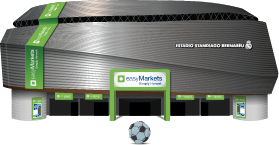Momentum Indicators
Understanding market momentum is essential for effective trading. Momentum indicators are technical analysis tools that help traders evaluate the speed and strength of price movements. When applied correctly, they provide insight into potential trend continuations or reversals, making them valuable for both entry and exit strategies.
In this guide, you’ll learn what momentum indicators are, how to use them, and how to integrate them into your trading strategy for better decision-making.

What are Momentum Indicators in trading?
Momentum indicators, also known as MOMs, are technical tools used to measure the pace and direction of price changes. While they don’t predict future prices, they can tell you whether a trend is gaining strength or losing steam.
These indicators are especially helpful in identifying overbought or oversold conditions and confirming trend strength. They are most effective when combined with other tools such as support/resistance levels, moving averages, or trendlines.
"Momentum indicators are important tools for traders, helping to identify potential trends and reversals in the market and providing insight into when to enter and exit positions." - Peter Brandt, Market Analyst
Top 3 Momentum Indicators explained
Different momentum indicators serve unique roles in technical analysis. Let’s break down the three main ones that traders rely on:
Relative Strength Index (RSI)
The RSI tracks the size and speed of recent price changes to tell you if an asset is overbought or oversold.
- • RSI >70: The asset might be overbought and due for a pullback.
- • RSI <30: It could be oversold and ready for a bounce.
The RSI is often paired with trendlines and support/resistance levels to spot potential trend reversals.
RSI formula:
RSI = 100 - [100/(1 + (Average Upward Price Movements/Average Downward Price Movements)]

Moving Average Convergence Divergence (MACD)
MACD compares two moving averages (EMAs) to identify shifts in momentum and trend direction.
- • MACD line crosses above signal line = potential upward momentum
- • MACD line crosses below signal line = possible bearish move
MACD formula:
MACD = 12-period EMA - 26-period EMA
Use MACD to confirm trend direction or anticipate early signs of trend exhaustion.

Stochastic Oscillator
This indicator compares an asset’s closing price to its price range over a set time period.
- • %K > 80: Asset may be overbought
- • %K < 20: Asset may be oversold
Stochastic Oscillator formula:
%K = (Current Close - Lowest Low) / (Highest High - Lowest Low) × 100
The Stochastic Oscillator is excellent for spotting momentum exhaustion and potential reversals before they’re visible in price action alone.
Case in Point: Tesla (TSLA) on May 2, 2025
To see how momentum indicators work together in a real market scenario, let’s take a look at Tesla’s stock performance on May 2, 2025:
- • MACD (12,26): 4.99 – A positive value like this means short-term momentum is stronger than the long-term trend, signaling bullish movement.
- • RSI (14): 57.66 –Sitting comfortably in the neutral zone, this suggests price stability, not overbought, not oversold.
- • CCI (14): 127.11 – A reading above +100 hints that the asset may be in overbought territory, which could lead to a short-term correction.
Taken together, these indicators reveal a nuanced picture: momentum is upward (MACD), price conditions are stable (RSI), but there’s a warning sign of potential overextension (CCI). The conclusion? There’s bullish energy, but it’s not a “go all-in” signal. A cautious, well-timed approach would be wise.
How to set up Momentum Indicators
To get accurate signals, you need to set up your indicators properly:
1. Choose your asset and timeframe (1-hour, daily, weekly, etc.).
2. Select the right indicator(s) based on your strategy, trends, reversals, or overbought/oversold zones.
3. Set your parameters:
- • Time Periods (e.g. 14 days for RSI),
- • Chart style: line or histogram
- • Visual preferences: Colours, overlays
Once you have configured everything, apply the indicator to your trading chart and start interpreting the data.
How to use Momentum Indicators in a trading strategy
Momentum Indicators help traders:
Spot entry/exit points
Based on trend strength.
Identify overbought
(Usually identified with an RSI >70)/oversold (RSI < 30) conditions that could signal a reversal.
Validate price movement
If the price is rising but momentum is falling, the trend might be losing steam.
Pro tip: Watch for divergence:
If the price is rising but the indicator is falling, the trend might be weakening. This divergence can be an early warning sign of a reversal.

The pros and cons of using Momentum Indicators
Pros
1. Detect trend reversals early
2. Clarify trend direction and filter noise
3. Adapt your strategy based on short-term or long-term momentum
Cons
1. Can give false signals in volatile or fast-moving markets.
2. Indicators based on past data may lag behind real-time price moves.
3. Relying too heavily on one tool can lead to mistimed trades. Always confirm with other indicators or market context.
Conclusion
Momentum indicators are among the most versatile and insightful tools in a trader’s toolkit. Used properly, and in combination with trendlines, support/resistance, or moving averages, they help you:
- • Catch trends earlier
- • Exit more confidently
- • Avoid emotional or impulsive trades
Understanding market momentum is essential for effective trading. Momentum indicators are technical analysis tools that help traders evaluate the speed and strength of price movements. When applied correctly, they provide insight into potential trend continuations or reversals, making them valuable for both entry and exit strategies.
In this guide, you’ll learn what momentum indicators are, how to use them, and how to integrate them into your trading strategy for better decision-making.
FAQs
Look for flattening price movement, lower highs, or divergence between price and momentum indicators. If major economic data doesn’t support the current trend, it might be time to reassess.
To read a Momentum Indicator, look for a sudden increase or decrease in the indicator's reading. When the indicator is rising, an asset's price is generally rising. If the indicator is falling, the asset price is decreasing. If an indicator is flat, the asset's price is fixed between a particular high and low point without making notable movements beyond this range.
At easyMarkets, the top-rated momentum indicators include:
- • Relative Strength Index (RSI)
- • Moving Average Convergence Divergence (MACD)
- • Stochastic Oscillator














